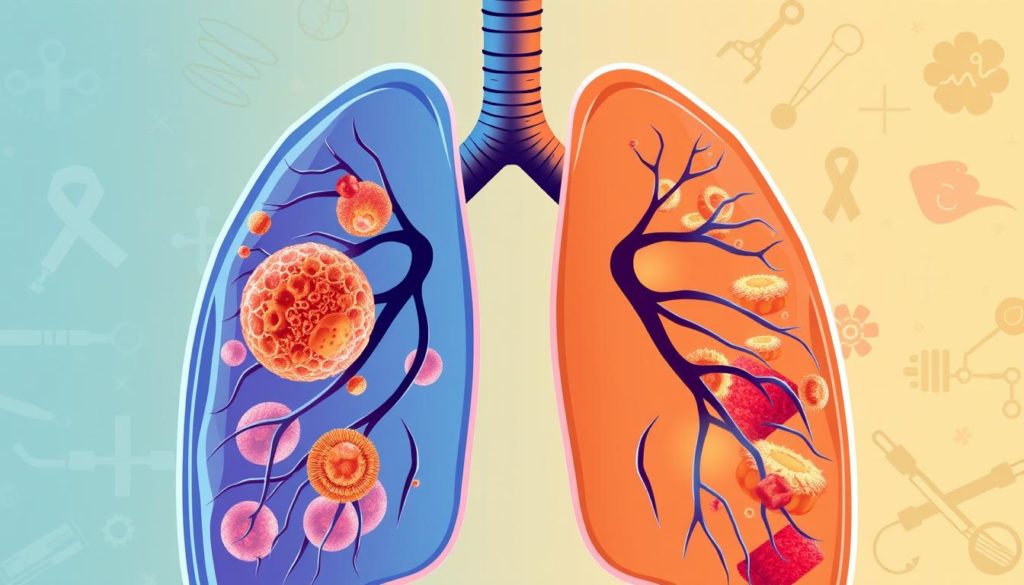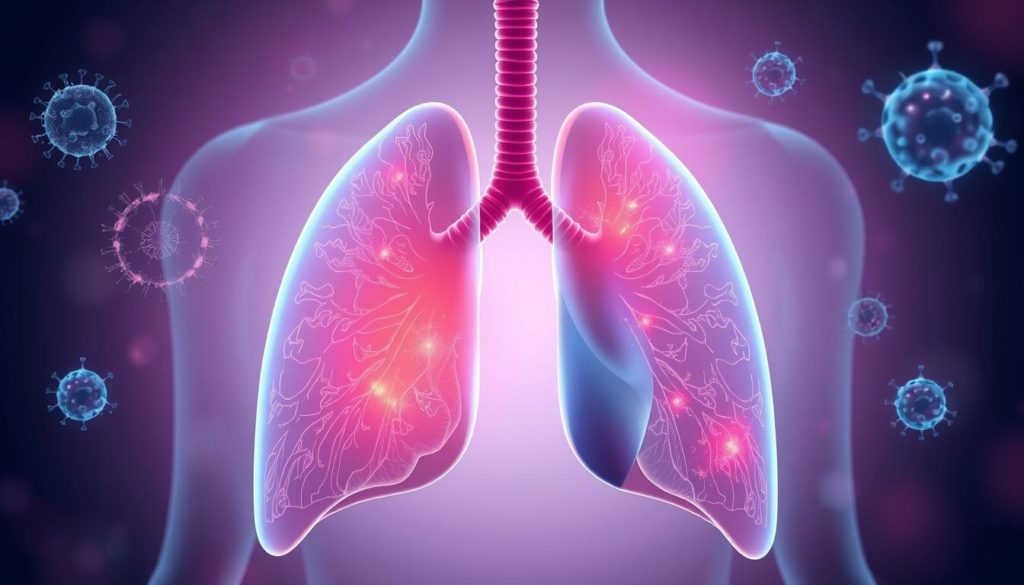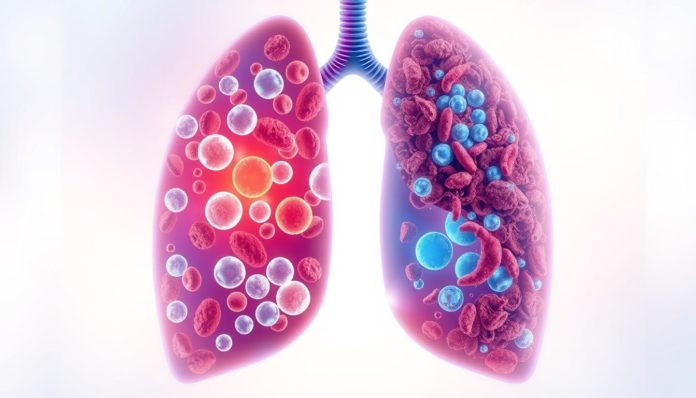Lung cancer causes nearly 25% of all cancer deaths in the U.S. This fact highlights the need for awareness and early detection. Lung cancer starts when lung cells mutate and grow out of control. This growth can form a tumor and damage nearby tissue.
It’s often thought that only smokers get lung cancer. However, nonsmokers can get it too. This is why regular screening is crucial, especially for those over 55 with a smoking history. Early detection increases survival rates by finding the disease early.
Now let’s explore the basics of lung cancer. We will look at its causes and the types of lung cancer. Knowing these facts could save lives.
Introduction to Lung Cancer
Lung cancer starts in the lungs’ spongy tissues, which are crucial for breathing. It’s important to know how vital our lungs are for keeping us breathing well. The right lung has three lobes, and the left has two. They contain alveoli, small air sacs, for gas exchange. These sacs are key to breathing.
The pleura and diaphragm’s roles are critical in any lung cancer discussion. The pleura is a thin layer around the lungs. It helps them move smoothly when we breathe. The diaphragm, a muscle, helps pull air in. Cancer in these areas can affect how we breathe.

Lung cancer is a top cause of cancer death worldwide. Understanding different lung cancers is vital. Doctors and medical writers help share this knowledge. They explain the complex types of lung cancer.
Let’s look closely at lung functions and their link to lung cancer:
| Component | Description | Relation to Lung Cancer |
|---|---|---|
| Lobes | Divisions of the lungs, with three on the right and two on the left. | Can be sites of tumor growth in thoracic cancer |
| Alveoli | Tiny air sacs responsible for gas exchange. | Damage can result in impaired breathing. |
| Pleura | Membrane surrounding the lungs. | Thoracic cancer can cause pleural effusion, leading to breathing difficulties. |
| Diaphragm | Muscle aiding in the breathing process by contracting and flattening. | Pulmonary neoplasm can hinder its movement. |
This gives a full view of lung cancer. Now, we can dive deeper into this serious disease.
What Is Lung Cancer?
Lung cancer happens when abnormal cells grow in the lungs. These cells mess with how we breathe. They might even spread to other body parts. The lung cancer description talks about its seriousness and how it leads to more deaths than other cancers.
Talking about what is lung cancer means looking at how our choices affect our health, like smoking. Smoking is the top thing that puts you at risk. It harms lung cells, making cancer more likely. But, it’s important to remember that even people who never smoked can get lung cancer because of other reasons. This shows how complicated this illness is.

Programs that help people stop smoking are key to fighting lung cancer. Teaching people about how smoking directly hurts their lungs can help stop the disease from starting. With more people knowing about this, we hope to see fewer cases of lung cancer and fewer people dying from it.
| Aspect | Description |
|---|---|
| Definition | Lung cancer involves the uncontrolled growth of abnormal cells in one or both lungs. |
| Primary Risk Factor | Cigarette smoking, which damages lung cells over time. |
| Affected Demographics | Both smokers and non-smokers, though smokers are at higher risk. |
| Prevention Efforts | Public health initiatives focused on smoking cessation and education. |
Causes of Lung Cancer
Lung cancer comes from many sources, with key factors playing a big role. Knowing these factors helps in stopping it early.
Smoking
Smoking is the top reason for lung cancer. Cigarette smoke harms lung cells right away and over time. This makes cancer more likely.
Being around smokers can harm non-smokers too. This is due to secondhand smoke.
Environmental Factors
Things in our environment also cause lung cancer. Radon gas, often in basements, raises the risk.
Jobs that expose people to harmful substances like asbestos or heavy pollution are risky. These dangers stress the need for safety in such places.
Genetic Predisposition
Genes play a role too. Having a family history of lung cancer increases your risk.
Genetic risks, along with harmful environments or smoking, make it more likely to get lung cancer.
Types of Lung Cancer
Lung cancer is divided into two main types based on cell traits and growth patterns. These are crucial in deciding how to treat it.
Non-small cell lung cancer (NSCLC) makes up about 85% of cases. It includes adenocarcinoma, squamous cell carcinoma, and large cell carcinoma. Adenocarcinoma starts in the lungs’ outer parts. Squamous cell carcinoma is often near a bronchus, in the middle.
Large cell carcinoma can be found in any part of the lung. It grows and spreads fast.
Small cell lung cancer (SCLC) is about 15% of all lung cancer. It grows quickly and spreads early. SCLC usually begins in the bronchi and quickly gets worse, often being advanced when found.
There are other lung cancer types, like lung carcinoid tumors and rare cancers. They are very different from the usual types and need special treatment. Knowing the specific type is key to making a treatment plan that works best.
Non-Small Cell Lung Cancer (NSCLC)
Non-Small Cell Lung Cancer, or NSCLC, makes up most lung cancer cases. Knowing about its different types is key for proper treatment. We’ll look at adenocarcinoma, squamous cell carcinoma, and large cell carcinoma.
Adenocarcinoma
Adenocarcinoma is the most common lung cancer found in both smokers and non-smokers. It starts on the lungs’ outer parts. This type grows slower than the others.
Squamous Cell Carcinoma
Smoking mainly causes squamous cell lung cancer, found in the lungs’ central parts. This highlights how quitting smoking can cut cancer risk.
Large Cell Carcinoma
Large cell lung cancer can start anywhere in the lung and spreads fast, which makes it hard to treat. Treatment often needs a mix of methods because it grows so quickly.
For more on NSCLC treatment and research, check the National Cancer Institute.
Small Cell Lung Cancer (SCLC)
Small cell lung carcinoma (SCLC) is a rare but aggressive type of lung cancer. It grows quickly and spreads early, posing big challenges for treatment. Most people find out they have it after it has spread from the lungs.
SCLC often reacts well to chemotherapy and radiation. But, it usually comes back, making long-term survival tough. Knowing how SCLC is different from other lung cancers helps doctors treat it better and improve outcomes.
Symptoms of Lung Cancer
Knowing the lung cancer signs early is key. Often, symptoms don’t appear until the cancer is advanced. Knowing early signs can greatly help in treatment.
Early Stage Symptoms
At the start, early symptoms of lung cancer might not be obvious. These include:
- Persistent cough
- Chest pain
- Hoarseness
- Shortness of breath
- Unexplained fatigue
Noticing and acting on these symptoms early can help manage the disease better.
Advanced Stage Symptoms
As the cancer grows, symptoms become clearer. Advanced lung cancer indications include:
- Unexplained weight loss
- Recurring respiratory infections
- Severe chest pain
- Bone pain or fractures
- Neurological issues like headaches or seizures
| Symptom | Description |
|---|---|
| Weight Loss | Sudden, unexplained loss of weight |
| Bone Pain | Persistent pain or fractures, indicating cancer spread to bones |
| Headaches | Neurological symptoms suggesting metastasis to the brain |
Watching for these signs and getting help early can change the course of lung cancer. For more info, check the American Cancer Society website.
Diagnosis of Lung Cancer
Finding lung cancer early greatly increases chances of survival. There are many ways to test and screen for lung cancer. These include:
- Imaging Technologies like CT scans
- Tissue Sampling for Tumor Analysis
- Biomarker Tests
To accurately diagnose, it’s crucial to know if it’s Non-Small Cell Lung Cancer (NSCLC) or Small Cell Lung Cancer (SCLC). Each type needs its own treatment. High-risk groups, like long-term smokers, benefit most from screening. Early detection means more options for treatment and better survival odds.
There’s ongoing research to make lung cancer testing better and easier to get to. New methods and focussed screenings are key in fighting lung cancer today.
Treatment Options for Lung Cancer
There are different ways to treat lung cancer based on its type and stage. Usually, treatment includes surgery, radiation therapy, chemotherapy, and targeted therapy. Each one fights cancer in its own way, working together for a better result.
Surgery
Surgery often comes first, especially for early lung cancer. Surgeons work to remove the tumor and nearby healthy tissue. This can get rid of the cancer, especially if it’s just in the lungs.
Radiation Therapy
Radiation uses high-energy beams to kill cancer cells. It’s an option when you can’t have surgery. Or it’s used after surgery to kill any leftover cancer cells. This treatment focuses precisely on cancer, saving healthy tissue.
Chemotherapy
Chemotherapy uses strong drugs to kill fast-growing cancer cells. You can take it by mouth or through a vein. It’s used when cancer spreads beyond the lungs. Sometimes, it’s combined with surgery or radiation to catch any missed cancer cells.
Targeted Therapy
Targeted therapy attacks cancer cells without harming normal cells. It works well for people with certain genetic changes. This therapy focuses on cancer’s growth and helps stop it. Adding this to treatment plans can often help beat lung cancer.
FAQ
What are the common causes of lung cancer?
Smoking is a major cause of lung cancer. It hurts lung cells. Secondhand smoke, radon gas, asbestos, arsenic, and genes also play a role.
What are the different types of lung cancer?
There are two main kinds of lung cancer. Non-Small Cell Lung Cancer (NSCLC) includes several subtypes. Small Cell Lung Cancer (SCLC) grows quickly and spreads early.
What are the symptoms of lung cancer?
Lung cancer at an early stage often shows no signs. Later, it can cause cough, chest pain, hoarseness, weight loss, and bone pain. Neurological issues, like headaches, can happen.
Seeing symptoms usually means the cancer is advanced. So, getting checked early is vital.
How is lung cancer diagnosed?
To diagnose lung cancer, doctors use CT scans, biopsies, and tests for specific markers. Knowing if the cancer is NSCLC or SCLC helps choose the right treatment.
Early and accurate diagnosis improves survival chances.
What are the treatment options for lung cancer?
Treatment depends on cancer’s type and stage. Options include surgery, radiation, and chemotherapy. Targeted therapy attacks specific cancer cell traits. Often, treatments are combined for better results.
How can one prevent lung cancer?
To prevent lung cancer, quit smoking and avoid secondhand smoke. Stay away from radon gas and workplace dangers. Live healthily and get screened if you’re at high risk.
How common is lung cancer in the United States?
Lung cancer is a top killer in the U.S., mainly due to smoking. It also strikes non-smokers. Better awareness and early checks can lower deaths by catching it early.


